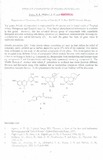Browsing Faculty of Science & Technology (FST) by Author "Yenesew, A."
Now showing items 1-4 of 4
-
Alkaloids and lignans from zanthoxylum usambarense and zanthoxylum chalybeum
Midiwo, J. O.; Yenesew, A.; Aluoch, A. 0.; Avoo, J. A. (Department of Chemistry, University of Nairobi,, 2011)The genus Zanthoxylum (Rutaceae) sometimes called 'prickly ashes' because of the shape of the leaves is represented by7 species in Kenya (l). Traditionally Zanthoxylum usambarense has been used to treat coughs, rheumatism, ... -
Antiplasmodial quinones from the rhizomes of Kniphofia foliosa.
Induli, M; Gebru, M; Abdissa, N; Akala, H; Wekesa, I; Byamukama, R; Heydenreich, M; Murunga, S; Dagne, E; Yenesew, A. (2013-09)Extracts of the rhizomes of Kniphofia foliosa exhibited antiplasmodial activities against the chloroquine-sensitive (D6) and chloroquine-resistant (W2) strains of Plasmodium falciparum with IC50 values of 3-5 microg/mL. A ... -
Flavonoids of the roots and stem bark of erythrina burttii and erythrina abyssinica
Midiwo, J. O.; Derese, S.; Yenesew, A. (Department of Chemistry, University of Nairobi,, 2011)The genus Erythrina belongs to the subfamily paplinoideae of the family Leguninosae. This genus is widely distributed in tropical and subtropical regions of the world and is represented by 125-200 species. The presence ... -
Surface compounds of psiadia punctulata
Yenesew, A.; Midiwo, J. O.; Juma, B. F. (Department of Chemistry, University of Nairobi,, 2001)The genus Psiadia (Compositae) is represented by 60 species and is found south of Tropical Africa, Madagascar and Tropical Asia (1). Very limited phytochemical information is available in this genus. However, this has ...


